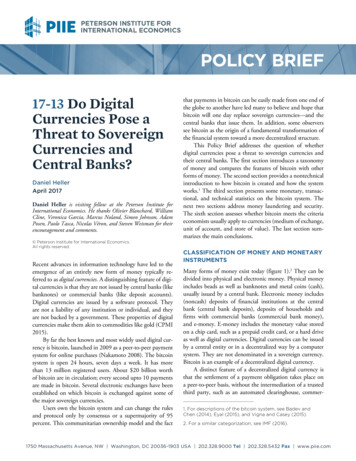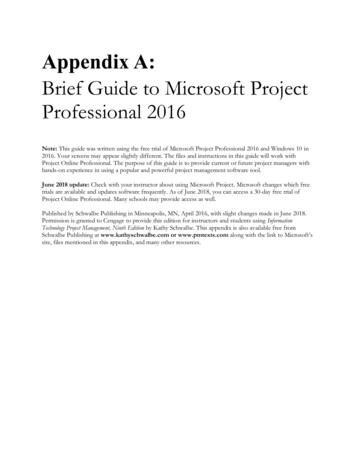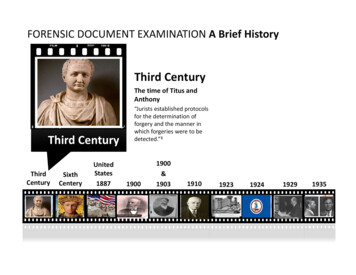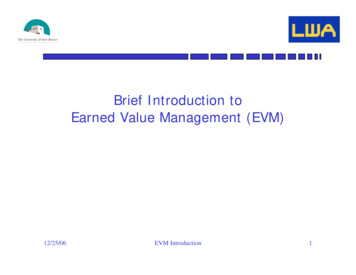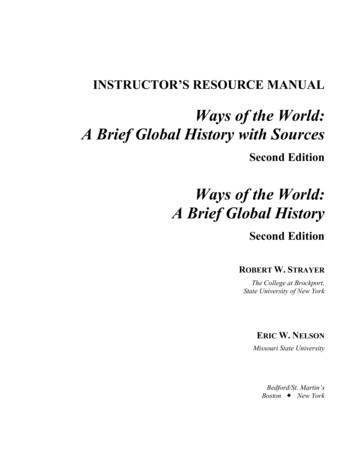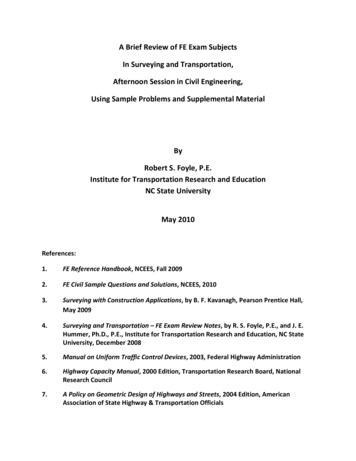
Transcription
A Brief Review of FE Exam SubjectsIn Surveying and Transportation,Afternoon Session in Civil Engineering,Using Sample Problems and Supplemental MaterialByRobert S. Foyle, P.E.Institute for Transportation Research and EducationNC State UniversityMay 2010References:1.FE Reference Handbook, NCEES, Fall 20092.FE Civil Sample Questions and Solutions, NCEES, 20103.Surveying with Construction Applications, by B. F. Kavanagh, Pearson Prentice Hall,May 20094.Surveying and Transportation – FE Exam Review Notes, by R. S. Foyle, P.E., and J. E.Hummer, Ph.D., P.E., Institute for Transportation Research and Education, NC StateUniversity, December 20085.Manual on Uniform Traffic Control Devices, 2003, Federal Highway Administration6.Highway Capacity Manual, 2000 Edition, Transportation Research Board, NationalResearch Council7.A Policy on Geometric Design of Highways and Streets, 2004 Edition, AmericanAssociation of State Highway & Transportation Officials
FE Exam SubjectsAfternoon Session in Civil EngineeringSURVEYING (6‐7 problems)A.Angles, distances, and trigonometryB.Area computationsC.ClosureD.Coordinate systems (e.g., GPS, state plane)E.Curves (vertical and horizontal)F.Earthwork and volume computationsG.Leveling (e.g., differential, elevations, percent grades)TRANSPORTATION (7 problems)A.B.Streets and highways1.Geometric design2.Pavement design3.Intersection designTraffic analysis and control1.Safety2.Capacity3.Traffic flow4.Traffic control devices
Surveying and Transportation FE Exam Review7Example – Area by Trapezoidal Rule and Simpson’s 1/3 Rule From Kavanagh, Surveying with Construction Applications Solution – Trapezoidal Rule:Area w[(h1 hn)/2 h2 h3 hn-1]Area w[(h1 h9)/2 h2 h3 h8] end trianglesArea 15.0[(26.1 20.0)/2 35.2 34.8 41.8 45.1 40.5 30.3 25.0] (8.1)(26.1)/2 (20.0)(11.1)/2Area 15.0[275.75] 105.71 111.00Area 4136.25 105.71 111.00 4352.96 ft2 43560 0.09993 acSolution – Simpson’s 1/3 Rule: n 2 n 1 Area w h1 2 hk 4 hk hn / 3 k 3,5,. k 2,4,. Area w[h1 2(h3 h5 h7) 4(h2 h4 h6 h8) h9]/3 end trianglesArea 15.0[26.1 2(34.8 45.1 30.3) 4(35.2 41.8 40.5 25.0) 20.0] /3 105.71 111.00Area 15.0[836.50] /3 105.71 111.00Area 4182.50 105.71 111.00 4399.21 ft2 43560 0.10099 acThe Institute for Transportation Research and Education, NC State University
Surveying and Transportation FE Exam ReviewI. SurveyingA. Angles, Distances, and TrigonometryAngles and Directions Bearing—angle from north or south, i.e., N 50 W Azimuth—angle from north, clockwise, i.e., 310 degrees Interior angles of closed traverse; sum (n 2)180 Deflection angle—how much angle to turn to keep following the alignment Latitude—north ( ) or south (-) component of line (p. 164 in FE Handbook)¾ Latitude distance cos (bearing )¾ Signs matter! Departure—east ( ) or west (-) component of line¾ Departure distance sin (bearing )( latitude ) ( departure )22 Distance departure Bearing tan 1 latitude Typically use degrees, minutes, and seconds¾ Get used to converting to and from decimals of degrees Precision—record on drawings to nearest second¾ Keep 5 decimal places when calculating with degreesThe Institute for Transportation Research and Education, NC State University3
15Surveying and Transportation FE Exam ReviewExample – Traverse ErrorGiven the following preliminary survey information, compute the error of closure, theaccuracy of the survey, and the corrected bearing and length for course AB. Alldistances are in feet.CourseBearingLengthLatitudeDepartureY, N-SX, E-WABS 44 32’11” W200.02′ 142.58 140.29BCN 49 09’58” W368.48′ 240.94 278.79CDN 28 29’34” E196.90′ 173.05 93.93DAS 50 08’38” E423.64′ 271.49 325.21Sum---------------1189.04′ 0.08 0.06Solution:Perimeter: lengths 1189.04′Sum of latitudes: 0.08′Sum of departures: 0.06′Error of closure:( 0.08) ( 0.06 )Survey accuracy:0.101 1189.04 x22 0.10′x 1189.04 118900.10 200.02 0.01 1189.04 Latitude correction for AB: 0.08 200.02 0.01 1189.04 Departure correction for AB: 0.06 The Institute for Transportation Research and Education, NC State University
23Surveying and Transportation FE Exam ReviewExample – Leveling From Kavanagh, Surveying With Construction Applications BM elevation 161.273 m Level location 1: BS to BM 2.868 m and FS to TP 0.982 m Level location 2: BS to TP 1.977 m and FS to Point Q 0.540 m In table form:StationBS, mHI, mBM2.868164.141TP1.977165.136Point Q FS, m161.2730.982163.1590.540164.596What is the elevation of Point Q?Location 1:HI 161.273 2.868 164.141 mEl. TP 164.141 – 0.982 163.159 mLocation 2:Elevation, mHI 163.159 1.977 165.136 mEl. Q 165.136 – 0.540 164.596 mThe Institute for Transportation Research and Education, NC State University
Surveying and Transportation FE Exam Review84Density and Speed The upper left curve is between density and speed. Greenshields assumed that thisrelationship was linear. The speed at which density is zero is called the free flow speed, vf (or Sf). Anassumption of 60 mph is common and useful. The density at which the speed is zero is called the jam density, kj (or Dj). Anassumption of 150 vpm is common and useful. Average vehicle spacing would be5280 ft/mi / 150 veh/mi 35 ft/veh, which is about right. The equation for the speed/density line would then look like: vv f k j 60 k v f k 60 0.4k 60 150 The Institute for Transportation Research and Education, NC State University
Surveying and Transportation FE Exam Review87Problem 22 – Traffic FlowAssume a linear relationship between speed and density, a jam density of 140 vpm, anda free flow speed of 70 mph for a freeway.(1)What is the capacity of the road?a) 2300 vphb) 2350 vphc) 2400 vphd) 2450 vph(2)At a volume of 1700 vph, under capacity, the average speed is most nearly:a) 56 mphb) 54 mphc) 52 mphd) 50 mph(3)At a volume of 1700 vph, under capacity, what is the density?a) 30.3 vpmb) 31.3 vpmc) 32.3 vpmd) 33.3 vpmThe Institute for Transportation Research and Education, NC State University
Surveying and Transportation FE Exam Review96Problem 23 – Traffic Control DevicesSeveral citizens have called the traffic engineering department complaining about howhazardous an intersection is and suggesting that a traffic signal should be installed.You are investigating the intersection and have collected the following traffic volumesand lane configurations.Is the peak hour warrant met for this intersection?a) Yes, plan for installation of a signalb) Yes, but investigate other relevant warrantsc) No, signal not warrantedd) No, but investigate other relevant warrantsThe Institute for Transportation Research and Education, NC State University
Surveying and Transportation FE Exam Review The Institute for Transportation Research and Education, NC State University 87 Problem 22 – Traffic Flow Assume a linear relationship between speed and density, a jam density of 140 vpm, and a free flow speed of 70 mph for a freeway. (1) What is the capacity of the road? a) 2300 vph b) 2350 vph c) 2400 vph d) 2450 vph (2) At a volume of 1700 vph .





